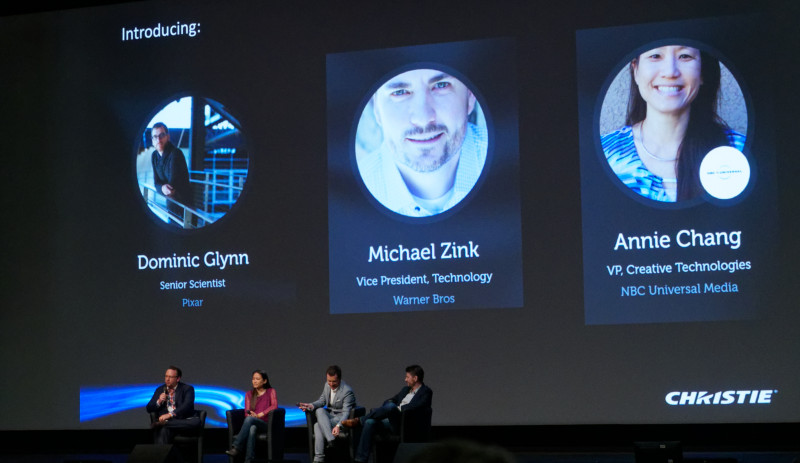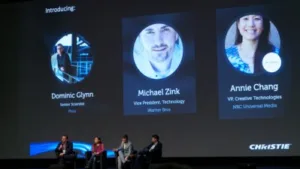Christie had a big screen demonstration that compared Xenon-based projection with a full laser unit. Unfortunately, because of a schedule clash, we didn’t get to see the different demonstration, but got into the session just as we got to questions. Brian Claypool of Christie (VP Product Management, Global Cinema – Christie Digital Systems) moderated the session.

The panelists were:
- Dominic Glynn – senior scientist – Pixar
- Michael Zink – VP Technology – Warner Bros
- Annie Chang – VP Creative Technologies – NBC Universal Media
Claypool asked the audience if could see some difference between the xenon and laser units and there was wide acknowledgment that there is a visible difference and Claypool seemed slightly surprised that, responding to the question, quite a lot would pay more for the better image quality.
In response to a discussion about whether more colour is needed, Glynn said that when offered more, his creative and technical people always want the biggest or brightest and always want more.
However, more colour in some projectors and displays means that you may need to create different versions. Chang said that ideally you would grade for every display but that is not completely practical as each version also has multiple language versions, so very quickly you get to unmanageable numbers of versions.
In response to this, Glynn said that directors want to create the best possible ‘master’ version, but typically they are not so worried about lower quality versions.
Chang said that in the home there is dynamic metadata to allow the adjustment possible to coptimise the content for the display, but cinema has DCP which has fixed parameters. She thinks that it might be a good idea in the future to go to a 600 cd/m² master version with dynamic metadata. Even dynamic metadata is not without some issues, though. Glynn said that consumers in the cinema want the highest possible quality – you mustn’t alter the colour or brightness too much to optimise for the display.
Claypool said that the demos that were shown was not really HDR, the black levels were a bit milky and Chang added that they were not “HDRey”. Zink said that he is not sure that consumers really notice really good black levels, even though professionals do. Christie doesn’t define the projectors as HDR as there is no accepted or official definition of the terms in cinema.
Glynn said that HDR is really a marketing term and you need definitions. If you charge more, the audience needs to understand why they are spending more. One of the problems with 3D in the cinema was that 3D content had to ‘poke you in the eye’ to prove there was something that you were paying for.
Do you need more brightness, Claypool asked? Zink said he wants as much brightness as possible.
 The panel. Image:Meko
The panel. Image:Meko
Audience Questions
In response to an audience question, Chang said that DCI is looking at a definition of HDR – you can see the memo at dcimovies.com
There was a question from an audience member who said that hardcore art houses don’t like (or even hate) colours. Festivals haven’t switched to laser because they simply don’t want more colour. Glynn said that often creatives have not known what is coming down the road in colour, but in his experience, artists don’t like things taken away. Chang said that just because you have a wider palette, you don’t have to use it. Technology gets better but you don’t have to use it. Even in a 4000 nit HDR container, you can still use just 25 if you want to. Glynn said that there is always a desire to protect what came before when setting new standards. Zink added that it is good to give artists more possibilities. It sometimes takes time for creatives to understand and learn how to use new technologies.
Inside Out (which had been shown in the demo, we understand) was edited in Low Dynamic Range. If you switch to HDR do you have to cut the film differently? In Inside Out, a babies birth is a sudden shock for the baby to go from black to very bright. There, having 100 cd/m² available makes a big difference compared to the 50 cd/m² standard. In that movie, the director wanted to create a sense of ‘shock’ for the audience with the extreme change.
Usually home video masters are made before the theatrical release and that can mean challenges in deciding how things should look. “Which is the true master?” becomes the question.
There was a question about high frame rates (HFR) and the use of ‘virtual shutters’ to allow creation at different frame rates. Zink said that releasing titles in HFR had been ‘an interesting experience’. At higher brightness, without HFR, you see more of the strobing effects. If you just demand that film makers go to HFR they will “run from the room”, but if you explain the problems of strobing, they may consider going to higher frame rates. Chang said you may want to have a variable frame rate shooting. Going to creating at 120Hz is probably excessive she believes. There are no file formats with variable frames and there is no way to display them at the moment in a standard way.
Zink said he and his creatives “always wants more”. Chang said that around eight years ago when the standard for imf was being decided, there was a decision to go with a fixed rate, although there was some discussion of variable rates being supported at the time. Maybe it’s time to start discussing an improvement to imf, she suggested. Claypool said that there is always change even in standards like imf that are intended to be ‘final’.
An audience member asked “If home TV gets good – why would you go to the cinema?”. Claypool said that research shows that people go to cinemas for lots of reasons other than just the quality of the image. However, you do have to raise the bar. Glynn said that the movie should be an event – going to the cinema, having a ticket, maybe being one of those that have seen an event film.

